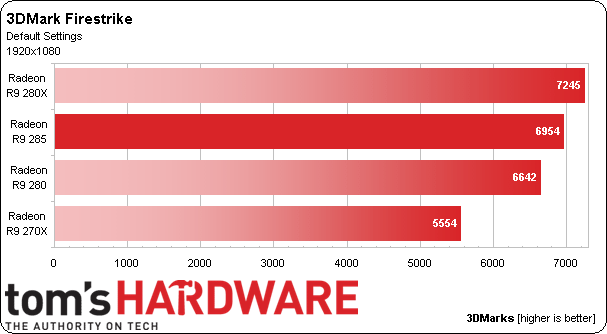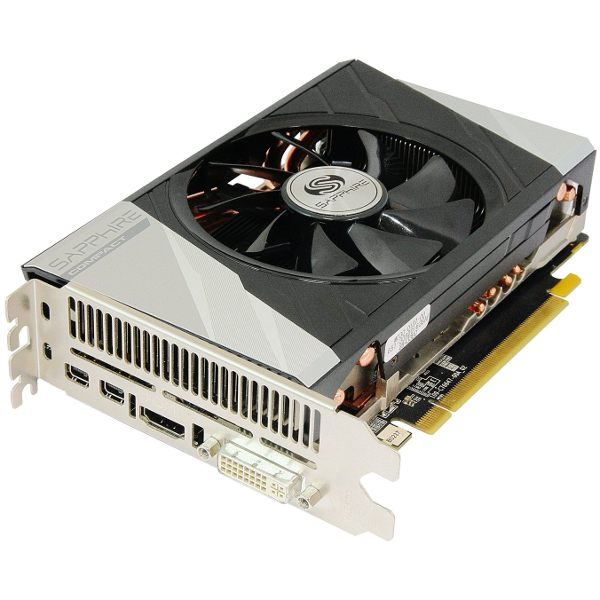AMD Radeon R9 285 Review: Tonga and GCN Update 3.0
On paper, the new Tonga-based R9 285 looks to be slightly slower than the R9 280 it is intended to replace, but there's more than meets the eye.
Why you can trust Tom's Hardware
Synthetic Benchmark Results
We'll begin our analysis with a couple of synthetic benchmarks, starting with 3DMark Firestrike:
We don't believe that the newest iteration of 3DMark is an ideal measure for comparing GPU architectures, but it does give us a useful glimpse into the Radeon product stack. Despite the slightly lower core clock and memory bandwidth compared to the Radeon R9 280, we see the Radeon R9 285 perform faster than its predecessor and land right between the Radeon R9 280 and 280X. Indeed, the improvements that AMD has made to the Tonga GPU have a substantial impact here.
Now let's see if Tonga's strengths will manifest in a GPGPU processing scenario. We took Sandra 2014 SP3's GPGPU cryptography benchmark for a spin:
The Radeon R9 285's lossless color compression can't help it here, and the new card's performance reflects its slightly lower core clock rate when it comes to GPGPU processing. Having said that, performance per watt have increased as we'll see in the power test results later on. Now let's move on to the game performance benchmarks.
Get Tom's Hardware's best news and in-depth reviews, straight to your inbox.
Current page: Synthetic Benchmark Results
Prev Page Test Setup and Benchmark Suite Next Page Titanfall and Battlefield 4 ResultsDon Woligroski was a former senior hardware editor for Tom's Hardware. He has covered a wide range of PC hardware topics, including CPUs, GPUs, system building, and emerging technologies.
-
JeanLuc The idle power consumption numbers are odd, the previous generation cards use less then at idle didn't they? Not that 15 watts is going to break anyone's bank account but its strange nether the less.Reply
Good to see AMD have tackled the noise and temperature issues that have plagued it's previous 28nm cards as well but it's a bit late in the day given that 20nm shouldn't be to far off now. -
gear999 Really nice article guys. I'm impressed by how the 285 actually was able to keep up with the 280. And I'm shocked by the fact that The $250 Nvidia card loses to a $170 AMD card. Thank god I bought a GTX 770 :PReply
Also, on the last page, you guys wrote R7 270X instead of R9, and in the chart it says "Relative to Radeon HD 7950 Boost". Oh, and in the Pros section, it says the 285 has R9 260 like performance?
Thanks for the proofread, fixing it now! :) -
Mike Stewart wow ! at 250$ it actually is a better card even than 280X !! and it was meant for 760....but as it shows here even a 270X is a WAY better card than 760....Reply -
tomfreak Had the tonga 285 come with a 6GHz/7Ghz GDDR5 & 4GB VRAM, the result will be a lot different. Whats with AMD putting on a 5500 memory? facepalm.jpgReply -
srap While this is really a third GCN iteration, showing it as a version number of 3.0 (as in: "Tonga and GCN Update 3.0") makes no sense for me.Reply -
Amdlova some one write this with a .45 acp on the head. I see some error on numbers models etc...Reply
I prefer get a r9 280 and downclock get same results. I can't see the point of this heat on graphics. maybe drivers. OR THIS IS HAWAII XT! Too much Heat! -
Amdlova ReplyI wanted to see the GPU die and OCing results. :(
I think the guys see if they hit the OC the room Will burn! maybe a problem with drivers.
Last time i see that Heat 290x tests. lol! -
Gillerer On the first page, it says "Improvements are always welcome but with the memory interface cut in half compared to the Radeon R9 280,...".Reply
But in fact, the memory interface was cut by a third (384 bit -> 256 bit), not half.
Good point, fixed! Thx.



